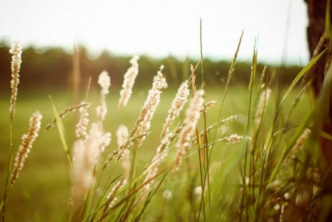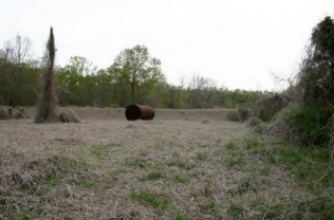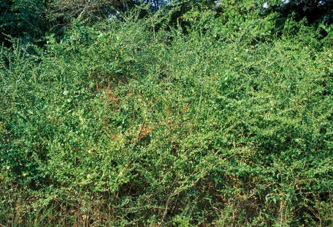Invasive Species
Lamar County is being invaded! We have become home to some of the worst invasive plant species in the state. These plants usually outcompete the native plants and can destroy our forests, pastures, and wildlife. Have you seen any of these?
Cogongrass
 Cogongrass is considered to be the 7th worst plant pest in the world. It was introduced to the United States in 1911-1912. It was used as packing material for imported goods.
Cogongrass is considered to be the 7th worst plant pest in the world. It was introduced to the United States in 1911-1912. It was used as packing material for imported goods.
It forms dense stands that crowd out native species. (Lippincott 1997)
Kudzu
 Description: Kudzu is a climbing, semi-woody, perennial vine in the pea family. Deciduous leaves have three broad leaflets up to 4 inches across. Leaflets lobed with hairy margins. Individual flowers, about 1/2 inch long, are purple, highly fragrant and borne in long hanging clusters. Flowering occurs in late summer and is soon followed by production of brown, hairy, flattened, seed pods, each of which contains three to ten hard seeds.
Description: Kudzu is a climbing, semi-woody, perennial vine in the pea family. Deciduous leaves have three broad leaflets up to 4 inches across. Leaflets lobed with hairy margins. Individual flowers, about 1/2 inch long, are purple, highly fragrant and borne in long hanging clusters. Flowering occurs in late summer and is soon followed by production of brown, hairy, flattened, seed pods, each of which contains three to ten hard seeds.
Threat: Kudzu kills other plants by smothering them under a blanket of leaves and by breaking branches or uprooting entire trees and shrubs through the sheer force of its weight. Kudzu plants grow rapidly, extending as much as 60 feet per season at a rate of about one foot per day. This vigorous vine may extend up to 100 feet in length, with stems up to 4 inches in diameter. Kudzu roots are fleshy, with massive tap roots 7 inches or more in diameter, 6 feet or more in length, and weighing as much as 400 pounds. As many as thirty vines may grow from a single root crown.
Alternative Plants: Trumpet creeper (Campsis radicans), pipevine (Aristolochia macrophylla), passionflower (Passiflora lutea), trumpet honeysuckle (Lonicera sempervirens), and native bittersweet (Celastrus scandens) have flowers and fruits, provide food for wildlife and make excellent substitutes for kudzu. (Source: http://www.mfc.ms.gov/invasive-species.php)
[button text=”NAFS Information Sheet” url=”http://na.fs.fed.us/spfo/invasiveplants/factsheets/pdf/kudzu.pdf” background_color=”#000000″ text_color=”#ffffff” style=”lt_flat” size=”default” icon=”” open_new_window=”true” rounded=”true”]
Privet
 Description: A flowering shrub, the Privet is native to Africa (north), Asia, Australia and Europe. It is often used in ornamental hedges and for flower arrangements. Being highly adaptable, the Privet shrub is able to displace vegetation. The invasive species of Privet are commonly found where the soil has been disturbed. The shrub is noted to grow very well in the forests in the southeastern United States.
Description: A flowering shrub, the Privet is native to Africa (north), Asia, Australia and Europe. It is often used in ornamental hedges and for flower arrangements. Being highly adaptable, the Privet shrub is able to displace vegetation. The invasive species of Privet are commonly found where the soil has been disturbed. The shrub is noted to grow very well in the forests in the southeastern United States.
Threat: New Zealand has banned the sale or cultivation of Privet. The Privet plant rapidly matures, resulting in greater dispersal due to a short generation period. When mechanically removed, root fragments can grow new plants through sprouting. More information can be found at the United States Department of Agriculture, Natural Resources Conservation Service website.
(Source: Urbatch, L. Chinese Privet: Plant Guide. USDA and NRCS.)
[button text=”National Park Service” url=”http://www.nature.nps.gov/biology/invasivespecies/” background_color=”#000000″ text_color=”#ffffff” style=”lt_flat” size=”default” icon=”” open_new_window=”true” rounded=”true”]
[button text=”USDA Information” url=”http://plants.usda.gov/core/profile?symbol=LISI” background_color=”#000000″ text_color=”#ffffff” style=”lt_flat” size=”default” icon=”” open_new_window=”true” rounded=”true”]
Chinese Tallow
 Description: Chinese tallow is a popular ornamental because of its fast growth rate, attractive fall color, and ability to resist damage from pests. It is a small tree that grows to about 20 feet tall, but some specimens can reach up to 50 feet. It is freely branching with leaves arranged alternately on branches. The leaves have acuminate tips and entire margins, with broadly ovate leaf blades and rounded bases. The Chinese tallow trees has flowers that are attractive to bees and other insects. It produces three-lobed capsule fruit that ripens from August to November. They are deciduous with a strong, deep taproot. This enables young trees to withstand periods of drought. Seeds are spread by birds, and moving water.
Description: Chinese tallow is a popular ornamental because of its fast growth rate, attractive fall color, and ability to resist damage from pests. It is a small tree that grows to about 20 feet tall, but some specimens can reach up to 50 feet. It is freely branching with leaves arranged alternately on branches. The leaves have acuminate tips and entire margins, with broadly ovate leaf blades and rounded bases. The Chinese tallow trees has flowers that are attractive to bees and other insects. It produces three-lobed capsule fruit that ripens from August to November. They are deciduous with a strong, deep taproot. This enables young trees to withstand periods of drought. Seeds are spread by birds, and moving water.
Threat: Chinese tallow can invade almost all habitats from wet to dry and from sun to shade. It often grows along roadsides, coastal areas, and streams. Some specimens can produce up to 100,000 seeds that may be eaten and dispersed by birds. Regrowth often occurs from cut stumps or roots. Native species are crowded out once Chinese tallow becomes established. The leaves and fruit are toxic to cattle and cause nausea and other sicknesses in humans.
Control: Prevention is an important control tactic for Chinese tallow. Landowners and homeowners are encouraged to remove full grown trees and seedlings from their property. Seedlings should be continually pulled by hand before they reach maturity. Alternative trees similar in size such as blackgum, maples, dogwood, and crape myrtles can be planted in areas previously occupied by Chinese tallow. Mature trees should be cut down with a chain saw. The final cut should be made as close to the ground as possible and as level as possible. This will make an herbicide application easier as well as prevent resprouting from the cut. Seedling trees can be mowed or disked when small. Burning is also very effective for both small and larger trees. There are no known biological control agents available for the control of Chinese tallow, however, it can be achieved with the use of triclopyr-ester applied in an oil diluent. (Source: http://www.mfc.ms.gov/invasive-species.php)
[button text=”USDA Plant Guide” url=”http://plants.usda.gov/plantguide/pdf/pg_trse6.pdf” background_color=”#000000″ text_color=”#ffffff” style=”lt_flat” size=”default” icon=”” open_new_window=”true” rounded=”true”]
[button text=”USGS Information Sheet” url=”http://www.nwrc.usgs.gov/factshts/154-00.pdf” background_color=”#000000″ text_color=”#ffffff” style=”lt_flat” size=”default” icon=”” open_new_window=”true” rounded=”true”]